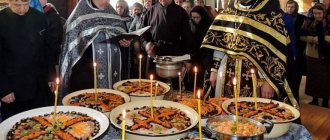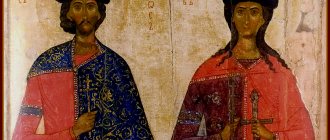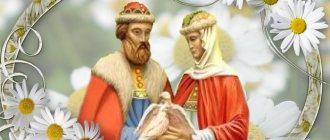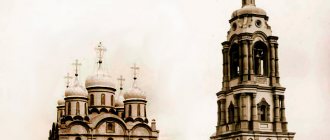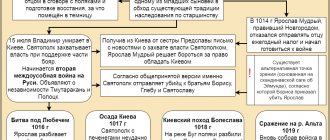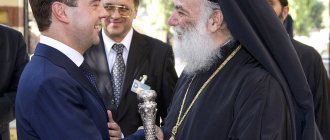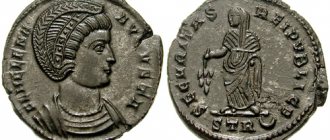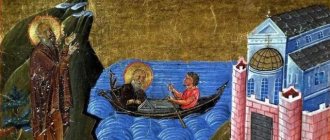| Yaroslav Svyatoslavich | |||||||||||||||||||||||||||
| Family of Prince Svyatoslav Yaroslavich. In the center is Yaroslav Svyatoslavich (Miniature of the handwritten “Selection of Svyatoslav”) | |||||||||||||||||||||||||||
| 1123 — 1127 | |||||||||||||||||||||||||||
| Predecessor: | Davyd Svyatoslavich | ||||||||||||||||||||||||||
| Successor: | Vsevolod Olgovich | ||||||||||||||||||||||||||
| Yaroslav Svyatoslavich (baptized Pankratiy) (1071/1072 - 1129) - Prince of Murom and Chernigov. The youngest son of the Kyiv prince Svyatoslav Yaroslavich and Oda, probably the daughter of Margrave Luitpold Babenberg, grandson of Yaroslav Vladimirovich the Wise. Founder of the Murom-Ryazan branch of the Rurikovichs.
| |||||||||||||||||||||||||||
Biography
He was most likely born in 1071 or 1072, since the marriage between his parents was concluded in 1070 or 1071, and in the miniature in the Izbornik of Svyatoslav, Yaroslav is no longer depicted as a baby.
According to some reports, he was brought up in Germany, where he was forced to flee with his mother after the death of his father. According to legend, Oda inherited large treasures from Svyatoslav, but was unable to take them all out and hid most of them. Later, returning to Rus', Yaroslav found them[1].
He first appears on the pages of the chronicle in 1096[2][3] in connection with his participation in the war in eastern Rus' (Murom, Ryazan, Rostov, Suzdal) against Vladimir Monomakh on the side of his brother Oleg. Svyatoslavich was then defeated on the river. Koloksha brothers Mstislav Vladimirovich and Vyacheslav Vladimirovich and the Polovtsians. After the defeat, Yaroslav went to Murom, and with the arrival of Mstislav’s troops near the city, he made peace with him.
In 1097, together with his brothers Oleg and Davyd, he participated in the congress of princes in Lyubech, at which the Chernigov principality was divided into three appanages. Chernigov went to Davyd Svyatoslavich, Novgorod-Seversky to Oleg Svyatoslavich, and the Murom-Ryazan principality, as the most distant and insignificant, went to his younger brother - Yaroslav.
In 1101, Yaroslav, together with other princes, participated in the conclusion of peace with the Polovtsians in Zolotch.
On March 4, 1103, he was defeated by the Mordovians[4].
Until Davyd's death in 1123, Yaroslav owned the Principality of Murom, which at that time included Ryazan. With Yaroslav’s transition from Murom to Chernigov in 1123, Vsevolod Davydovich settled in Murom.
In 1127, Vsevolod Olgovich expelled Yaroslav Svyatoslavich, his uncle, from Chernigov, and flogged and robbed his squad. Prince of Kiev Mstislav Vladimirovich, united with his brother Yaropolk of Pereyaslavl, went against Vsevolod (the Monomakhovichs went against the Olgovichi), demanding that he return Chernigov to Yaroslav. Vsevolod no longer acted with weapons, but with gifts, bribing the Kyiv boyars so that they would be his intercessors before the Grand Duke, and so it lasted until the winter. In winter, Yaroslav came from Murom to Kyiv and began to hurry Mstislav, begging him for help. Mstislav, who had previously promised to defend Yaroslav’s patrimony and kissed the cross, was just about ready to go on a campaign, but then the abbot of the St. Andrew’s Monastery, Gregory, known to everyone as a righteous and honest man, dissuaded him. Mstislav made peace with Vsevolod, and sent Yaroslav to Murom without returning his patrimony. Two years later, Yaroslav died. Buried in Murom.
Our Lady, "The Most High Star" [edit]
Theotokos The Brightest Star
The icon depicts a full-length image of the Theotokos with a star emitting rays of light in the background. The origin of its name is associated with poetic chants in honor of the Blessed Virgin Mary. At Her right hand stands the Baby Jesus. At her feet are the Murom saints: St. Konstantin, Mikhail and Feodor in princely robes and Sts. Peter, Fevronia and Ulyana put on monastic robes. At the bottom of the icon there is the following inscription: “This Marvelous Image is the Brightest Star of the Most Holy Theotokos, the Queen of Heaven” [5].
Konstantin Svyatoslavich
The holy noble prince Konstantin Svyatoslavich of Murom is sometimes identified with Yaroslav Svyatoslavich[5]. Konstantin Svyatoslavich is known from his life, written in the 16th century, and is unknown from chronicles. According to his life, he finally converted Murom to Christianity and built churches there. The life time of this prince is quite difficult to establish. In addition to identifying him with Yaroslav Svyatoslavich, there are other versions, for example, O. Rapov believed him to be the son of Svyatoslav Drevlyansky.
The name of Konstantin’s wife is known - Irina (mentioned only in the “Life” of her husband, and also depicted in some hagiographic icons. She was buried in the Murom Annunciation Cathedral. She is a locally revered Murom saint). Their children are also known from the Life:
- Mikhail Konstantinovich
- revered as an all-Russian saint; died in Murom at a young age at the hands of pagans[6]. - Feodor Konstantinovich
- revered as an all-Russian saint, inherited the Murom throne after the death of his father; sometimes identified with Yuri Yaroslavich.
The memory of Konstantin Muromsky is celebrated on May 21/June 3. Canonized together with his sons by the Makarievsky Cathedral in 1547.
| Opening of the relics of Saints Constantine, Michael and Feodor in the Cathedral of the Annunciation Monastery. Murom, 1919 | |||||||||
Holy blessed princes Constantine and his sons Mikhail and Theodore of Murom
Share
The holy noble prince Constantine came from a noble family. His great-grandfather was Grand Duke Vladimir, who baptized the Russian land. For Constantine, the establishment of Christianity in Rus' became a matter of life. As well as for his sons Michael and Theodore, whom their father raised from infancy in the spirit of the Christian faith.
The prince decided to baptize the pagans living in the city of Murom. Before Konstantin, his relative Gleb tried to do this. But the Murom residents refused to accept Baptism and killed Gleb. This did not scare Konstantin. For the sake of the Orthodox faith, he was ready to risk his life.
Together with his army, his wife Irina and sons, the prince went to Murom. The pagans closed themselves in the city and decided to defend themselves to the last. The prince's army surrounded Murom. Constantine could only wait until hunger forced the inhabitants to surrender. But the prince, as a true Christian, did not want to destroy anyone. And he considered it a temporary delusion of the Murom residents that they considered him - Konstantin - their enemy. The prince offered peace to the besieged in the name of Christ. The pagans did not believe that life was being given to them so easily. They took Konstantin’s noble gesture for a cunning trap and replied that they would accept the prince’s offer if he left them his son as collateral.
Unhappy Konstantin did not know what to decide. Give up conscience and faith or, risking the life of your son, send him to the pagans. That night of his terrible choice, the prince did not sleep a wink. His youngest son, nine-year-old Mikhail, began to ask what was bothering his father. Konstantin did not want to talk, but the boy asked questions endlessly and the prince told him everything. What he heard in response was not the speech of a boy, but of a husband. Mikhail replied: “Father, what you are telling me is the same thing that you told me about our salvation! If you send me to your enemies, you will act as our Heavenly Father acted in relation to the human race, and I will act as Christ did: I will come as a reconciliator!”
Prince Konstantin could not object. He always encouraged his children to live according to the Christian faith, and his son proved true to this principle even in such a critical situation. In the morning Mikhail went to Murom. He walked openly, without guards, through the forest, then got out into a clearing and headed towards the city gates. There was deafening silence all around. People couldn’t believe their eyes: the child was going to reconcile two peoples. He went because he was raised in the Christian faith. His mission was extremely simple: to persuade the people of Murom to open the gates for their Christian father. But Mikhail did not have time to enter the city. Someone shot an arrow at him. The boy fell. And then something happened that no one expected. People rushed to Mikhail from both sides: their own and strangers. They forgot about their enmity and did not think that bloodshed might begin. Everyone tried to bring Mikhail to his senses, but the boy was dead. And people cried with grief. It reconciled them. Enemies became friends. This was done by a small child raised by his father to believe in the Gospel and in Christ. The pagans allowed Constantine into Murom, but refused to replace paganism with the Orthodox faith.
The grief-stricken prince did not take revenge on anyone. And he didn’t forcefully implant faith either. At the site of Michael’s death, he built the Church of the Annunciation of the Blessed Virgin Mary and buried his son there, and then erected another church in the name of Saints Boris and Gleb. Konstantin acted slowly but surely: from time to time he addressed the Murom residents with a sermon about Christ. The most fierce opponents of Constantine once rebelled. They swore never to accept Christianity and went to the prince with threats to deal with him. Constantine's family locked themselves in the temple and prayed. During prayer, the prince heard a voice saying to him: “Constantine! Your prayer has been answered. Go and don’t be afraid of anything, I’m with you.” The prince went out to the rebels. He raised the holy image above his head and the crowd fled from the porch: the icon glowed with an unearthly light. The repentant pagans agreed to receive Baptism.
This is how Constantine established the Orthodox faith in Murom. He lost his youngest son, and in the person of the eldest Theodore he found a faithful assistant. Together they built temples and established monasteries. Together we helped those in need. When Konstantin died, the people of Murom mourned him as a close relative. The prince found his last refuge in the Church of the Annunciation, which he built, next to his sons. And four centuries later, princes Constantine, Michael and Theodore were canonized by the Orthodox Church.
Ancestors
| Svyatoslav Igorevich | ||||||||||||||||
| Vladimir Svyatoslavich | ||||||||||||||||
| Malusha | ||||||||||||||||
| Yaroslav Vladimirovich the Wise | ||||||||||||||||
| Rogvolod Polotsk | ||||||||||||||||
| Rogneda Rogvolodovna | ||||||||||||||||
| Svyatoslav Yaroslavich | ||||||||||||||||
| Eric VI (King of Sweden) | ||||||||||||||||
| Olaf (King of Sweden) | ||||||||||||||||
| Sigrid the Proud | ||||||||||||||||
| Ingigerda, Princess of Sweden | ||||||||||||||||
| leader of the Obodrites | ||||||||||||||||
| Estrid Obodritskaya | ||||||||||||||||
| Yaroslav Svyatoslavich Muromsky | ||||||||||||||||
| Leopold I (Margrave of Austria) | ||||||||||||||||
| Adalbert the Victorious | ||||||||||||||||
| Rihvara, Countess of Zualafeldgau | ||||||||||||||||
| Leopold (Margrave of Hungary) | ||||||||||||||||
| Immed IV | ||||||||||||||||
| Glizmod, Countess of Utrecht | ||||||||||||||||
| Adela Hamaland | ||||||||||||||||
| Ode of Stadenska | ||||||||||||||||
| Bruno I (Count of Brunswick) | ||||||||||||||||
| Ludolf (Count of Brunswick) | ||||||||||||||||
| Gisela of Swabia | ||||||||||||||||
| Ida von Elsdorf | ||||||||||||||||
| Hugo VI (Count of Nordgau) | ||||||||||||||||
| Gertrude, Countess of Nordgau | ||||||||||||||||
Notes
- L.E.
Morozova. [www.tinlib.ru/istorija/velikie_i_neizvestnye_zhenshiny_drevnei_rusi/p7.php#metkadoc3 Great and unknown women of Ancient Rus']. - [imwerden.de/cat/modules.php?name=books&pa=showbook&pid=1745 Laurentian Chronicle] // PSRL. - L., 1927. - T. 1. - Stb. 238.
- [imwerden.de/cat/modules.php?name=books&pa=showbook&pid=1765 Ipatiev Chronicle] // PSRL. - St. Petersburg, 1908. - T. 2. - Stb. 228.
- [www.bibliotekar.ru/rus/2-3.htm The Tale of Bygone Years]
- [dugward.ru/library/ilovayskiy/ D. I. Ilovaisky
] - Michael, saints of the Orthodox Church // Encyclopedic Dictionary of Brockhaus and Efron: in 86 volumes (82 volumes and 4 additional). - St. Petersburg, 1890-1907.
Links[edit]
- ^ a b
Walsh, Michael J., "Constantine of Murom",
New Dictionary of Saints: East and West
, Liturgical Press, 2007 ISBN 9780814631867 - Murom-Ryazan Icon of the Mother of God
- Venerable Constantine (baptized Yaroslav) with the children Michael and Theodore, miracle workers of Murom,” Orthodox Church in America.
- Sukhov, Oleg, "Murom: Murom still lives in a fairy tale", The Moscow Times
, November 25, 2012. - Icon of the Mother of God “Bright Star”.
- (Greek) ματουργοί.
21 αΐου. ΜΕΓΑΣ ΣΥΝΑΞΑΡΙΣΤΗΣ.
Excerpt characterizing Yaroslav Svyatoslavich
“He’s sweating,” said Prince Andrei. - I came to you to tell you this. The child moved slightly in his sleep, smiled and rubbed his forehead on the pillow. Prince Andrei looked at his sister. The radiant eyes of Princess Marya, in the matte half-light of the canopy, shone more than usual from the happy tears that stood in them. Princess Marya reached out to her brother and kissed him, lightly touching him to the canopy of the crib. They threatened each other and stood still in the dull light of the canopy, as if not wanting to part with this world in which the three of them were separated from the whole world. Prince Andrei was the first, tangling his hair on the muslin canopy, to move away from the crib. - Yes. “This is the only thing left for me now,” he said with a sigh. Soon after his admission into the brotherhood of Masons, Pierre, with a complete manual written for himself about what he was supposed to do on his estates, left for the Kyiv province, where most of his peasants were located. Arriving in Kyiv, Pierre called all the managers to the main office and explained to them his intentions and desires. He told them that measures would be immediately taken to completely free the peasants from serfdom, that until then the peasants should not be burdened with work, that women and children should not be sent to work, that the peasants should be given assistance, that punishments should be used exhortations, not corporal ones, that hospitals, shelters and schools should be established on every estate. Some managers (there were also semi-literate economists) listened in fear, assuming the meaning of the speech was that the young count was dissatisfied with their management and withholding money; others, after the first fear, found Pierre’s lisp and new, unheard words funny; Still others simply found pleasure in listening to the master speak; the fourth, the smartest, including the chief manager, understood from this speech how to deal with the master in order to achieve their goals. The general manager expressed great sympathy with Pierre's intentions; but he noticed that in addition to these transformations it was necessary to generally take care of matters that were in a bad state. Despite the enormous wealth of Count Bezukhy, since Pierre received it and received, as they said, 500 thousand an annual income, he felt much less rich than when he received his 10 thousand from the late count. In general terms, he had a vague sense of the next budget. About 80 thousand were paid to the Council for all estates; It cost about 30 thousand to maintain a house near Moscow, a Moscow house and princesses; about 15 thousand went into retirement, the same amount went to charitable institutions; 150 thousand were sent to the countess for living expenses; interest was paid for debts of about 70 thousand; the construction of the begun church cost about 10 thousand during these two years; the rest, about 100 thousand, was spent - he himself did not know how, and almost every year he was forced to borrow. In addition, every year the chief manager wrote either about fires, or about crop failures, or about the need to rebuild factories and factories. And so, the first task that presented itself to Pierre was the one for which he least of all had the ability and inclination - getting busy with business. Pierre worked with the chief manager every day. But he felt that his studies were not making any progress. He felt that his activities took place independently of the case, that they did not touch the case and did not force him to move. On the one hand, the chief manager presented matters in the worst possible light, showing Pierre the need to pay debts and undertake new work with the help of serfs, to which Pierre did not agree; on the other hand, Pierre demanded that the matter of liberation be started, to which the manager argued that it was necessary to first pay the debt of the Guardian Council, and therefore the impossibility of quick execution. The manager did not say that this was completely impossible; To achieve this goal, he proposed the sale of forests in the Kostroma province, the sale of grassroots lands and Crimean estates. But all these operations in the manager’s speeches were associated with such complexity of processes, lifting prohibitions, demands, permits, etc., that Pierre was at a loss and only told him: “Yes, yes, do that.” Pierre did not have that practical tenacity that would give him the opportunity to directly get down to business, and therefore he did not like him and only tried to pretend to the manager that he was busy with business. The manager tried to pretend to the count that he considered these activities very useful for the owner and shy for himself. There were acquaintances in the big city; strangers hastened to get acquainted and cordially welcomed the newly arrived rich man, the largest owner of the province. The temptations regarding Pierre's main weakness, the one that he admitted during his reception to the lodge, were also so strong that Pierre could not refrain from them. Again, whole days, weeks, months of Pierre’s life passed just as anxiously and busyly between evenings, dinners, breakfasts, balls, not giving him time to come to his senses, as in St. Petersburg. Instead of the new life that Pierre hoped to lead, he lived the same old life, only in a different environment. Of the three purposes of Freemasonry, Pierre was aware that he did not fulfill the one that prescribed every Freemason to be a model of moral life, and of the seven virtues, he completely lacked two in himself: good morals and love of death. He consoled himself with the fact that he was fulfilling another purpose - the correction of the human race and had other virtues, love for one's neighbor and especially generosity. In the spring of 1807, Pierre decided to go back to St. Petersburg. On the way back, he intended to go around all his estates and personally verify what was done from what was prescribed to them and in what situation the people were now, which God had entrusted to him, and which he sought to benefit. The chief manager, who considered all the ideas of the young count almost madness, a disadvantage for himself, for him, for the peasants, made concessions. Continuing to make the task of liberation seem impossible, he ordered the construction of large school buildings, hospitals and shelters on all estates; For the master's arrival, he prepared meetings everywhere, not pompously solemn ones, which, he knew, Pierre would not like, but just the kind of religious thanksgiving, with images and bread and salt, just the kind that, as he understood the master, should have an effect on the count and deceive him . The southern spring, the calm, quick journey in the Viennese carriage and the solitude of the road had a joyful effect on Pierre. There were estates that he had not yet visited - one more picturesque than the other; The people everywhere seemed prosperous and touchingly grateful for the benefits done to them. Everywhere there were meetings that, although they embarrassed Pierre, deep down in his soul evoked a joyful feeling. In one place, the peasants offered him bread and salt and an image of Peter and Paul, and asked permission in honor of his angel Peter and Paul, as a sign of love and gratitude for the good deeds he had done, to erect a new chapel in the church at their own expense. Elsewhere, women with infants met him, thanking him for saving him from hard work. At the third estate he was met by a priest with a cross, surrounded by children, whom, by the grace of the count, he taught literacy and religion. In all the estates, Pierre saw with his own eyes, according to the same plan, the stone buildings of hospitals, schools, and almshouses, which were to be opened soon, erected and erected. Everywhere Pierre saw reports from managers about corvée work, reduced compared to the previous one, and heard for this the touching thanksgiving of deputations of peasants in blue caftans. Pierre just didn’t know that where they brought him bread and salt and built the chapel of Peter and Paul, there was a trading village and a fair on Peter’s Day, that the chapel had already been built a long time ago by the rich peasants of the village, those who came to him, and that nine-tenths The peasants of this village were in the greatest ruin. He did not know that due to the fact that, on his orders, they stopped sending children of women with infants to corvee labor, these same children carried out the most difficult work in their half. He did not know that the priest who met him with the cross was burdening the peasants with his extortions, and that the disciples gathered to him with tears were given to him, and were bought off by their parents for a lot of money. He did not know that the stone buildings, according to the plan, were erected by their own workers and increased the corvee of the peasants, reduced only on paper. He did not know that where the manager indicated to him in the book that the quitrent was reduced by one third at his will, the corvée duty was added by half. And therefore Pierre was delighted with his journey through the estates, and completely returned to the philanthropic mood in which he left St. Petersburg, and wrote enthusiastic letters to his mentor brother, as he called the great master.
Iconography and temples of St. Blagv Prince Theodore, David and Constantine of Yaroslavl
Holy blessed princes Theodore, David and Konstantin of Yaroslavl. Con. XV century Rostov lands (Yaroslavl?). 62.2 × 49.6 × 2.7. Wood (linden), two boards, two mortise one-sided dowels, ark, pavolok, gesso, tempera. The centerpiece and margins of the icon in ancient times were covered with a continuous basma frame, traces of the attachment of rims and tsat.
Origin unknown. Purchased for the museum in 2008 in Yaroslavl. Previously: collection of V. M. Momot (Moscow).
Disclosed in 2008 by V. M. Momot.
The base in the upper parts has several cracks, including a through one in the right board with the loss of the author's painting, filled with new tinted primer. The same inserts are at the joint of the boards, above Constantine’s halo, in the lower part of the soil. Numerous minor losses of paint layer, restoration repairs, tinting. In the places where the solid basma flashing, rims and tsat are attached there are significant soil chips. The painting is very worn.
The image of the holy prince of Smolensk and Yaroslavl Theodore with his sons David and Constantine, in accordance with the tradition of Russian princely iconography, represents a kind of triple portrait of the ruler-father with two children - heirs to the throne. The compositional scheme goes back to the image of the Kyiv prince Vladimir with his sons Boris and Gleb, but is also known from the image of the Murom wonderworkers Constantine with the princes Mikhail and Theodore. The iconography of the “triads” of the Kiev, Yaroslavl and Murom princes, associated with the sacred symbolism of the number three, corresponded to liturgical texts in which the triple union of father and sons was glorified as a “wonderful trinity” of saints, “reflecting the trisolar light”, “three together shining like the sun” .
Iconographic portraits of the holy Yaroslavl princes appeared only in 1563–1564: fresco images in the Spaso-Perobrazhensky Cathedral of the Yaroslavl Monastery, the Archangel Cathedral of the Moscow Kremlin, as well as similar middles of two simultaneously painted hagiographic icons from the YaMZ collection, including a temple one from the local row of the iconostasis Spassky Cathedral in 1564. They all vary the same iconography: in the center stands the blessing Prince Theodore in a schema (sometimes with a scroll), placing his hand on the shoulder of his youngest son. On both sides are depicted the small figures of the young princes David and Constantine, close to their father, turning towards him with hands folded in prayer, in princely robes, but devoid of any attributes of princely power. The creation of a whole series of solemn images of the Yaroslavl wonderworkers Theodore, David and Constantine with lives and miracles, apparently, is associated with the beginning of the all-Russian glorification of saints, whose lives in the middle of the 16th century. was included in the royal list of the Great Mena of the Four and was highly revered by Ivan the Terrible.
The published icon belongs to another, the most ancient iconographic tradition: the full-length figures of the holy princes, presented strictly frontally, repeat the characteristic type of tombstone image and go back to the composition of the sewn cover of 1501 with the reliquary of the incorruptible relics of the wonderworkers. The burial of three princes in one coffin, noted by the chronicler when their relics were found, predetermined the unusual composition of the cover. The strongly elongated and closely spaced figures of the saints and the monastic image of Theodore, much taller than his sons, exactly correspond to the words of an eyewitness to the event of 1463: “The three great princes were lying, Prince Theodore Rostislavich and his children... lying on top of the ground. Prince Fyodor himself was great... he was tall, and both Kostyantin and Davyd lay under his bosoms, even smaller than his height... in a single coffin.”
On the icon in question, as well as on the cover, the figures of the princes are painted separately: Theodore blessing him in the monastic schema, with a scroll, David and Constantine in princely fur coats thrown over their shoulders, and hats trimmed with fur, and with swords in their hands, emphasizing the high princely the dignity of those depicted. This lost in the 16th century. a feature indicating recognition of the power of the Yaroslavl princely family could appear and be maintained only in the last years of the existence of the princely throne. In subsequent centuries, none of the numerous images of Saints Theodore, David and Constantine contain this detail; swords are not mentioned in the descriptions of iconographic originals, the texts of which almost completely preserved the chronicler’s vivid story.
On the published icon both brothers are depicted as very young, innocent youths. The symmetry of the figures is enhanced by the color of their clothes, varying the same colors. The small size of the ancient icon indicates the composition of the first iconography of the saints before their official canonization. It should be noted that in Rus' the tradition of small gravestone icons was known: images of the same size (approx. 65 × 50 cm) stood at the tombs of the Volotsk princes Ivan and Fyodor Borisovich at the beginning of the 16th century. in the Assumption Cathedral of the Joseph-Volokolamsk Monastery and were paired portraits of the buried and their heavenly patrons.
The time of creation of the published icon is no later than the end of the 15th century, which allows us to see in it one of the first, if not the earliest, images of the Yaroslavl miracle workers, close to the time of their glorification. The process of canonization of saints usually included several stages, but only with the advent of the hagiographic text and the liturgical canon intended for execution on the day of church remembrance, an embroidered portrait cover was placed on the shrine, and a funerary icon depicting the saint was placed next to the relics. In the Transfiguration Cathedral, such a memorial complex appeared no earlier than the late 1480s–1490s, as evidenced by the ancient cover with the image of Saints Theodore, David and Constantine, the sewing of which began no earlier than the late 1490s. and ended with the solemn laying of it in 1501. The first funerary icon of the miracle workers should also be dated to this time. Most likely, the monument being published is one of her replicas (perhaps made for the Rostov bishop?), although it cannot be ruled out that it was intended to decorate the tomb of the newly-minted saints. The fact that in ancient times this was a revered image is evidenced by the rich setting that once adorned it: silver basma, crowns, tsats.
The stylistic features of the icon suggest the Rostov origin of the master. This is evidenced by light, elongated and slender figures with soft streamlined silhouettes and clearly defined contours on a light yellow background, sparse and straight draperies of clothes with pointed and angular shapes, translucent liquid paints, but especially the color typical of Rostov painting, based on blue, brown, soft red and yellow colors. The monument reveals a close stylistic resemblance to the “Archangel Michael” icons of the last quarter of the 15th century. from the GMZRK and “Boris and Gleb” from the collection of A.I. Anisimov (Tretyakov Gallery), consonant with it in the proportional, coloristic and figurative structure of fragile and slightly angular figures. The character of the dark personal letter, distinguished by an even olive sankir and dense ocher, without the use of spaces, goes back to the techniques of the masters of Deesis icons of the mid-15th century. from the Church of Paraskeva Pyatnitsa on Vspolye in Yaroslavl (YAM). Especially the style of execution of the faces of the Yaroslavl wonderworkers is close to the paleos figures on the end-of-the-century icon “Our Lady Hodegetria with Selected Saints” from the Church of St. Basil the Great in Uglich (YAM). The images are similar not only to the nature of the olive-ocher modeling, but also to the characteristic pattern. Based on materials from the website “Museum of Russian Icons”.
